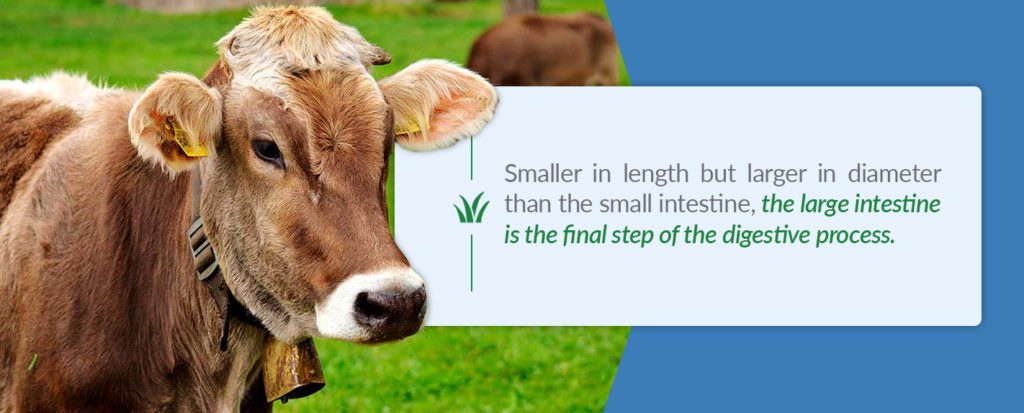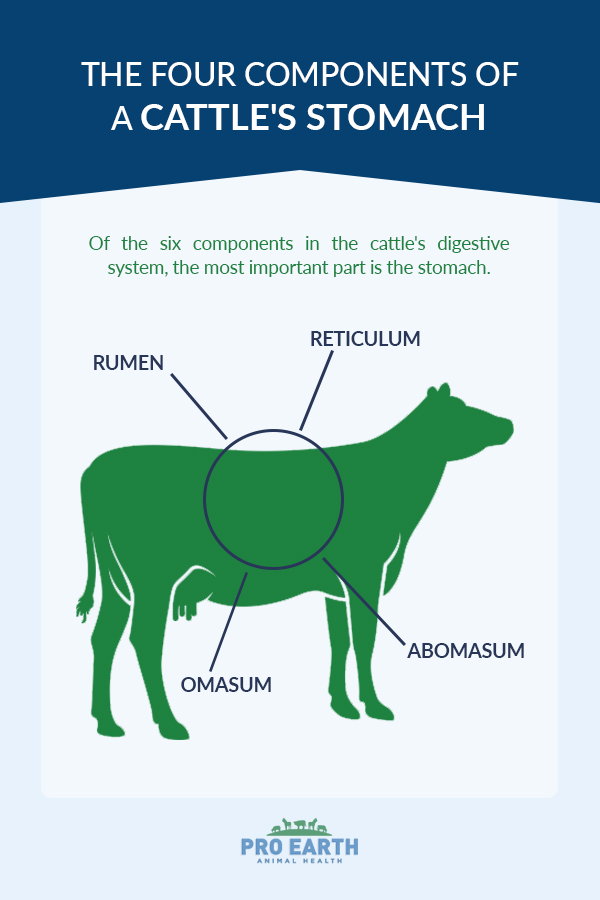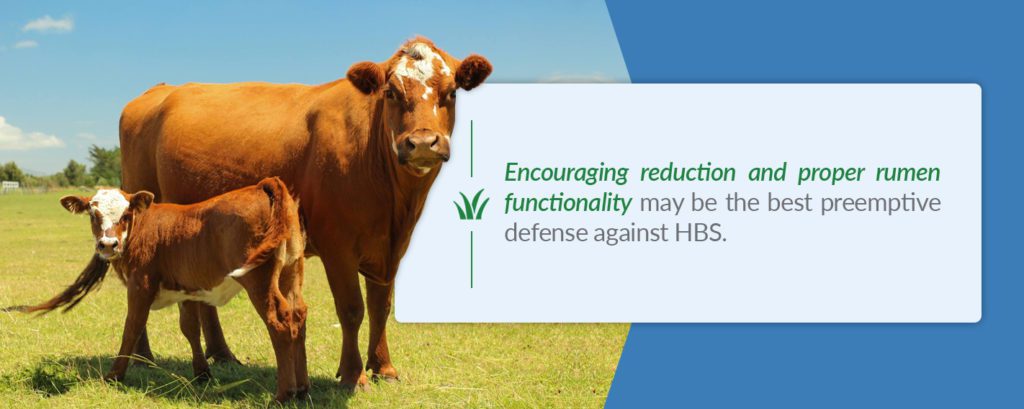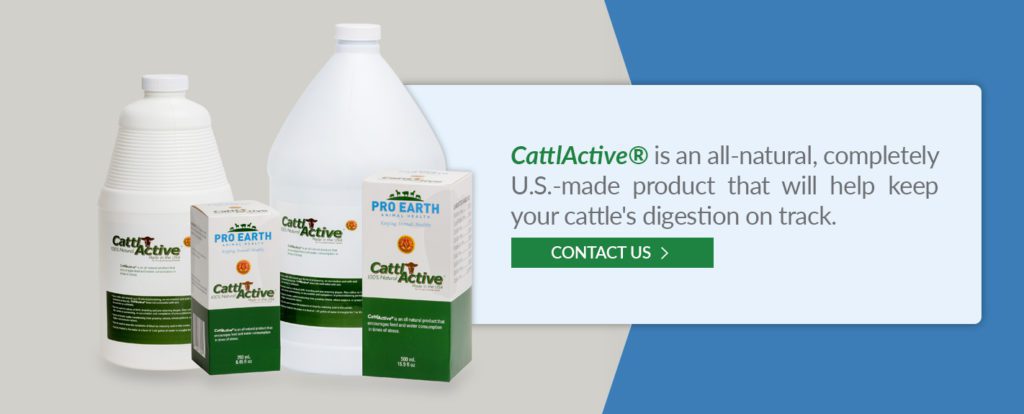Cows Four Stomachs Functions Why Are Beef Plants Aranged the Way They Are
What is a ruminant? Ruminant animals are set autonomously from other mammals by their circuitous digestive systems. The way they process nutrient, absorb nutrients and gain energy is different from other herbivores.
The main distinction in a moo-cow's digestive organization, or a ruminant digestive organization is that the stomach has 4 separate compartments, each with a unique function, whereas virtually other animals only take a single compartment with a unified functionality.
The four compartments permit ruminant animals to assimilate grass or vegetation without completely chewing it first. Instead, they only partially chew the vegetation, and then microorganisms in the rumen department of the stomach pause down the rest. Animals with singular stomach compartments — known equally a monogastric digestive arrangement — do not have the aforementioned capability.
Many dissimilar animals accept this unique iv compartment breadbasket blazon of digestive system, including:
- Cattle
- Sheep
- Goats
- Water buffalo
- Deer
- Elk
- Giraffes
- Camels
These animals convert plant affair and vegetation into useable free energy more than efficiently than other herbivores.
In cattle and dairy cows, the development, pH rest, functionality and leaner levels of the digestive arrangement are crucial to maintaining overall health and high yield.
While some parts of the ruminant digestive system are similar to those of non-ruminant systems, several essential components perform the necessary functions for digestion.
Tabular array of Contents
- Components of the Ruminant Digestive Organization
- Oral cavity
- Esophagus
- Tum
- Modest Intestine
- Cecum
- Large Intestine
- The Iv Components of a Cattle'south Stomach
- Rumen
- Reticulum
- Omasum
- Abomasum
- The Development of the Rumen
- Most Mutual Issues With a Cattle's Digestive System and What to Do
- Rumen Impaction
- Hemorrhagic Bowel Syndrome (HBS)
- Acidosis
- Fatty Liver
- Caring for Your Cattle's Digestive System
Components of the Ruminant Digestive Organization
While the ruminant digestive tract operates differently from the monogastric organisation, it is composed of the same 6 basic components:
1. Mouth
The mouth is where the process begins. Cattle will graze by wrapping their tongues around plants and tearing, pulling them into their mouth for mastication. They chew kickoff with the lower jaw incisors, working confronting a difficult dental pad on the forepart part upper palate, then second with the molars, grinding plant cloth down further. Chewing stimulates saliva production and the saliva mixes with plant thing before the animal swallows. Saliva contains enzymes capable of breaking down fats and starches and helps to buffer the pH levels in the reticulum and rumen segments of the stomach. Mature cattle will swallow from l to 80 quarts daily to aid in digestion, but the amount varies based on how much time they spend chewing.
ii. Esophagus
When the cattle swallows the plant material and saliva mix, it will travel downwards the esophagus to the rumen. The esophagus performs the swallowing activeness through waves of muscle contractions, moving the feed down. Information technology has a bidirectional function, meaning it can movement feed from the mouth to the stomach or from the stomach to the rima oris. Cattle need the latter to regurgitate "cud," or the under-chewed institute matter and grain, back upward to the mouth for further grinding. Once the moo-cow is finished chewing the cud, it again swallows the thing back down to the stomach.
3. Breadbasket
Generally, the stomach functions to farther intermission down plant matter and grain. More specifically, in that location are iv sections of the stomach — rumen, reticulum, omasum and abomasum — each with a particular task to exercise. These sections shop chewed plant material and grain, blot nutrients and vitamins, break down proteins, aid in beginning digestion and deliquesce material into processable pieces. The next section will focus more closely on the responsibilities and functions of each tummy compartment.
4. Small Intestine
The pocket-size intestine has three main sections — the duodenum, jejunum and ileum — that work together to consummate most of the actual digestive process. In the duodenum, the section continued to the stomach, secretions from the gallbladder and pancreas mix with the partially digested matter. This process balances the pH in the intestine, ensuring the digestive enzymes piece of work correctly. The jejunum department is lined with small, finger-like projections known as villi, which increase the intestinal surface surface area and blot nutrients. The ileum absorbs vitamin B12, bile salts and whatsoever nutrients that passed through the jejunum. At the cease of the ileum is a valve, preventing whatsoever astern catamenia of materials. Throughout the pocket-size intestine, muscular contractions movement the matter forward. In a fully mature cow, the entire organ may be upward to 150 feet long and has a twenty-gallon chapters.
5. Cecum
Sitting betwixt the small and large intestines is a three-human foot-long pouch chosen the cecum. It has little role besides providing storage and a transition between the two intestines, but it does assistance in the continual breaking down of fabric. The cecum has most a two-gallon holding capacity.
vi. Large Intestine
Smaller in length just larger in diameter than the small intestine, the large intestine is the concluding step of the digestive process. It absorbs remaining water and contains bacteria microbes that finish digestion and produce vitamins the animate being needs to grow and remain healthy. Its final chore is to eliminate any undigested and unabsorbed nutrient from the system in the form of waste matter.
When the cow is properly handled and fed, this process continually occurs, keeping the animal salubrious and at the right weight. The unabridged digestion procedure should take anywhere from one to three days.
If something interrupts this procedure or the cattle is unhealthy, the sections volition no longer exist able to role as well as they should, causing diseases and complications.
 The Four Components of a Cattle's Tum
The Four Components of a Cattle's Tum
Of the half dozen components in the cattle'due south digestive system, the nigh important part is the tum. A ruminant creature's stomach has four singled-out compartments, each with its specific part. These compartments are:
1. Rumen
 The rumen, besides known as the "paunch," is the first surface area of the cow'due south stomach, connected to the cattle's esophagus. This compartment acts equally storage for chewed vegetation and forms balls of cud. Cud consists of large, non-digestible pieces of constitute matter that must be regurgitated, chewed a second time and swallowed before standing through the process. The rumen absorbs nutrients through papillae of the rumen wall and facilitates fermentation, creating the rumen bacteria and rumen microbes necessary to intermission downward and assimilate the proteins in feed. Microorganisms in the rumen are responsible for digesting cellulose and complex starches, as well equally synthesizing protein, B vitamins and vitamin Chiliad. Equally a storage area, information technology tin hold upwardly to 40 gallons of cloth. The rumen, combined with the reticulum, makes upward 84% of the volume of the entire tum. A few common health issues with the rumen include bloat, which occurs when a moo-cow can't eradicate a buildup of gas, acidosis and rumenitis, which occur when low pH residual allows for loftier acid production. These can exist prevented by managing and paying attending to cattle's food and water intake.
The rumen, besides known as the "paunch," is the first surface area of the cow'due south stomach, connected to the cattle's esophagus. This compartment acts equally storage for chewed vegetation and forms balls of cud. Cud consists of large, non-digestible pieces of constitute matter that must be regurgitated, chewed a second time and swallowed before standing through the process. The rumen absorbs nutrients through papillae of the rumen wall and facilitates fermentation, creating the rumen bacteria and rumen microbes necessary to intermission downward and assimilate the proteins in feed. Microorganisms in the rumen are responsible for digesting cellulose and complex starches, as well equally synthesizing protein, B vitamins and vitamin Chiliad. Equally a storage area, information technology tin hold upwardly to 40 gallons of cloth. The rumen, combined with the reticulum, makes upward 84% of the volume of the entire tum. A few common health issues with the rumen include bloat, which occurs when a moo-cow can't eradicate a buildup of gas, acidosis and rumenitis, which occur when low pH residual allows for loftier acid production. These can exist prevented by managing and paying attending to cattle's food and water intake.
two. Reticulum
The reticulum is frequently referred to as the "honeycomb," because the inner lining appears like and is structured similar to a honeycomb. While it does have its independent functionality, the reticulum is attached to the rumen with but a thin tissue divider. This component holds heavy or dense objects — such as metallic pieces and rocks — and trap large feed particles that are not modest enough to be digested. The reticulum facilitates regurgitation. Both the rumen and reticulum contain digestive bacteria, so no acid is included in the regurgitation of materials. The reticulum holds virtually v gallons of textile. 1 common health issue involving the reticulum is hardware disease, which occurs when cattle ingest heavy or sharp objects — like nails, screws or wire. They are swept into the reticulum and may puncture the stomach wall. This illness is preventable by putting magnets on feeding equipment to catch any metal, or cured by the placement of an intraruminal magnet that traps already swallowed objects.
iii. Omasum
The world-shaped omasum is nicknamed "manyplies" because of its internal structure. Information technology is lined with large leaves and folds of tissue that resemble the pages of a volume. These folds blot water and nutrients from feed that passes through after its second round of chewing. The omasum is smaller than the rumen and reticulum, making up about 12% of the stomach'south total volume. It tin can concur up to nigh 15 gallons of material.
4. Abomasum
The abomasum is the terminal component of the stomach and is often known as the "truthful stomach," because it operates the most like to a not-ruminant stomach. This true breadbasket is the but compartment of the stomach lined with glands. These glands release muriatic acid and digestive enzymes to help the abomasum further intermission down feed and plant material. In comparison to the other chambers, the abomasum is on the smaller side, representing virtually 4% of the total stomach volume and simply belongings about vii gallons of material.
Each of these components is vital in maintaining a healthy digestive procedure. They must cooperate quickly and efficiently to turn grain and plant matter into free energy for the cattle. If ane section becomes incapable of performing or ceases to work correctly, information technology will affect all of the other functions in the digestive system.
Because the rumen is the largest area of the tum and the department that focuses on reducing feed to exist passed through the digestive procedure, it is crucial that it is properly developed and remains healthy.
The Development of the Rumen Compartment of the Tum
The ruminant organisation relies very heavily on the rumen segment of the stomach. For cattle to catechumen nutrient into energy, their rumen must exist healthy at all times and properly adult. All cattle handlers, including both beef cattle and dairy cows, demand to know how to ensure the success of a calf's stomach growth.
When a dogie is born, it begins its life as a functionally non-ruminant animal. It has the ruminant anatomy, only but the abomasum is fully developed at the fourth dimension of birth. This is the compartment that has a similar processing ability to the homo stomach.
While the other three chambers are present, they remain undeveloped and out of utilise as long every bit a calf continues feeding solely on milk. As the calf begins to consume starter grain and forage, bacteria microbes showtime to develop in the rumen and reticulum. The farther fermentation of these bacteria is what causes the rumen to brainstorm development.
Milk and liquid substitutes featherbed the rumen and reticulum, merely dry feed collects in these areas, get-go the chemical changes necessary for development. Dry feed absorbs h2o already ingested past the cattle, providing the right conditions for bacteria growth.
That bacteria then helps to metabolize nutrients and produce volatile fatty acids, effectively lowering the pH of the rumen by way of neutralizing acids and improving bacteria growth.
The acids produced by bacteria provide energy for the rumen wall to abound. Butyric acid does non blot through the wall, then all the energy it produces goes straight to the development of the organ. Other acids provide energy for the entire calf to grow, which contributes to the digestive system organs, as well.
Weaning is 1 of the most significant key factors in the evolution of the rumen. Timing the weaning process correctly is crucial. The calf's rumen should be allowed time to develop earlier weaning the calf off of liquid feeds entirely. Information technology takes well-nigh three weeks of pregnant starter grain intake daily for whatsoever calf to develop its rumen to the bespeak where the weaning procedure can begin.
This time menstruum allows for the establishment of a sufficient microbial population and absorptive chapters for connected normal growth without the help of liquid feed. If the calf is weaned before this stage, the calf may lose weight or non abound for the three weeks it takes the rumen to develop.
To encourage proper rumen development, handlers need to maintain a certain level of care for all calves, keeping them well fed, housed and managed.Calves need to feed to gain the nutrients and free energy that supplement growth. But, if it is stressed or sick, a dogie may refuse to eat. For this reason, information technology is crucial that their surround is consistently low-stress and that they remain healthy. They should also accept a costless choice of clean, attainable h2o.
They may too reject to eat starter grains that seem unpalatable, such as those that incorporate besides much dust or are moldy. Handlers should be sure to store starter grains and so they are well-kept, without take chances of contamination or mold growth, or whatsoever other element that may discourage a dogie from eating.
Handlers should be consistently paying attention to a calf's intake and eating habits. Additionally, they should maintain the correct residue of liquid and solid feeds. If overfed with the liquid variety, a dogie will be discouraged to eat solid grains.
Whatever incorrect practices tin pb to delays in rumen development, sometimes taking twice as long or longer to accomplish full maturity.
Most Common Issues With a Cattle'south Digestive Organization and What to Do
Because the ruminant digestive organization has so many stages, numerous things can go wrong and cause complications. If anything inhibits the process, the afflicted cattle may develop an illness, refuse to eat or even gamble expiry.
The most common ruminant digestive system bug are:
1. Rumen Impaction
The contents of a cattle's rumen should be allowed to menstruation and move freely with proper hydration. Merely, without sufficient water intake, boxy materials — including overly dense plant matter and high acid detergent cobweb feeds — can pile up and compress inside the rumen. This will prevent move throughout the remainder of the digestive system and keep it from functioning normally. To prevent rumen impaction, cattle need to have access to clean water and handlers should pay attention to whether or not they are drinking an average daily amount.
ii. Hemorrhagic Bowel Syndrome (HBS)
Unfortunately, there isn't whatsoever i specific cause for this illness, as scientists have been unable to reproduce circumstances that cause HBS in cattle successfully, and so diagnosing a direct reason can exist difficult. All the same, in that location are a few potential catalysts to consider, including molds and mycotoxins, Clostridium perfringens type A or other bacteria like Due east. coli, improper direction while trying to achieve higher milk production in dairy cows, or excessive dirt, soil, gravel, sand or rocks mixed in with feed. By and large, HBS is the result of a blood clot obstacle or blockage inside the small intestine, which becomes distended. If this syndrome goes uncorrected, the fatality rate is exceedingly high. In that location are no guaranteed solutions or preventative measures, but maintaining rumen health may decrease the chances of HBS from developing. If the rumen fails to reduce feed well enough, it tin pass forward obstructions and starches that feed unwanted bacteria and mycotoxins. So, encouraging reduction and proper rumen functionality may be the best preemptive defence force confronting HBS.
 3. Acidosis
3. Acidosis
Acidosis is a metabolic disease occurring direct within the rumen segment of the tummy. It can be brought on by several factors, including some other disease, excessive or wrong handling that causes the animal stress and also much concentrate, not enough forage. Any of these catalysts may atomic number 82 to general complications and heightened susceptibility to diseases such as bovine respiratory disease or scours. Acidosis is a cyclical affliction. When a catalyst causes the ruminal pH to shift to 5.v or lower, the rumen ceases to motion, making the afflicted cattle decrease its nutrient and h2o intake. The combination of the pH imbalance and decreased intake causes the amount of acid collecting in the rumen to increment, further discouraging the cattle from eating and drinking. Equally this causes good bacteria to dice off, releasing toxins and standing the increasing corporeality of collecting acid, the animate being volition continue to avoid any kind of intake. If let worsen, this bike can compromise the intestine linings, leading to leaky gut syndrome, weakening the creature's immune organisation or potentially resulting in death. Successfully encouraging eating and drinking is the only way to pause this wheel.
4. Fatty Liver
Fat liver is what it sounds like — excessive accumulation of fat in the cow's liver. The potential for this illness is mutual in cows effectually calving time. It's typically caused by a negative energy balance, which occurs due to the growth of a calf, the beginning of colostrum production and a decrease in dry matter intake. These factors crusade the cow to interruption downwards too much fat for the liver to handle. This broken downwardly fat is converted to fatty in the liver, an endeavor to forbid toxicity. Fat liver tin begin developing inside 24 hours of a cow going off feed and will not decrease on its own until the moo-cow can retain a positive energy balance. Symptoms of fatty liver include a decrease in ambition, lower quantity milk yields, milk fever, ketosis, mastitis, retentiveness of fetal membranes and a reduction in fertility. To prevent fatty liver in cattle, handlers need to proceed cows at an ideal body condition and encourage a low-stress environment, including no sudden changes in their overall surround or feeding regimen. Handlers should generally avoid anything that may cause a reduction in feed intake.
Each of these diseases and syndromes is more common in loftier producing cows, which require consistently loftier food and water intake. Nigh of these issues occur in areas of the digestive organisation after the rumen, but the rumen's reactive response can be severe for the cow's health.
While changes and imbalances in a cattle's health and digestive system are ordinary, there are means to prevent common digestive issues for cattle through regulating the process and the functionalities of each internal organ.
Caring for Your Cattle'south Digestive System
Gut wellness is crucial to ensuring any moo-cow's long term health. The digestive functions of your cattle require balance, as any imbalance can severely touch the animal'southward overall health.
Complications frequently arise from common catalysts, such as stress or changes in eating patterns. Little changes similar these can mean big issues for the rumen and successive problems for other areas of the creature'southward digestive organisation. If the animal'southward digestion isn't progressing correctly, they become prone to severe and potentially deadly diseases and excessive weight loss.
Signs of Potential Digestive Bug to Watch Out For in Beef Cattle and Dairy Farming
Because of the serious nature of these conditions, you need to pay close attention to the potential for or direct signs of digestive issues. Lookout for cattle refusing to eat or drinkable, suffering from weight loss, diarrhea or lethargy, maintaining an elevated pulse and respiratory rate or more often than not behaving unusually.
If any of these symptoms prove and persist in your cattle, you lot may need to find a way to re-regulate their digestive systems.
Be Proactive With the Digestive Health of Your Cattle
Pro Globe Animate being Health created CattlActive® for this purpose. CattlActive® is an all-natural, completely U.S.-made product that will help keep your cattle's digestion on track. It works by neutralizing excess acrid in the rumen, easing bloat symptoms, increasing nutrient utilization, preventing ulcers and encouraging your cattle to eat and drink.
By maintaining your cattle'southward regular digestion procedure and eating habits, you can help them stave off diseases and discomfort.
Yous tin purchase this product on our website. You can also contact us with any personal questions or concerns.

Source: https://proearthanimalhealth.com/how-does-the-digestive-system-work-in-a-cow-understanding-the-ruminant-digestive-system/
0 Response to "Cows Four Stomachs Functions Why Are Beef Plants Aranged the Way They Are"
Post a Comment